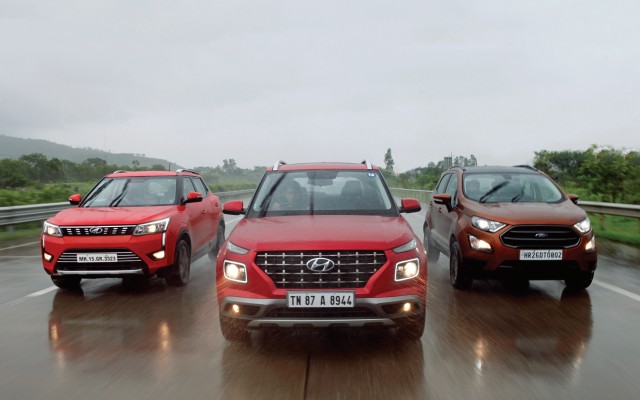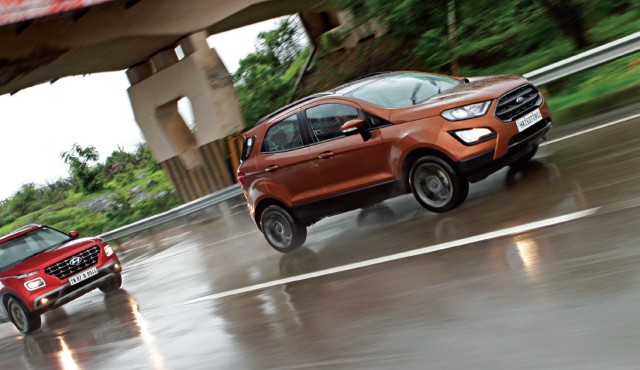The pursuit of efficiency, while also satisfying the SUV cravings, has taken a turn for the compact. While some focus more on affordability, some others step up and offer a little more oomph. Has the party moved to a new venue?

Story: Jim Gorde
Photography: Saurabh Botre
I was recently contacted by an acquaintance from a former workplace about buying a car. The requirements were seemingly simple, and I quote: ‘a petrol automatic SUV around Rs 15 lakh with ample rear space, fuel economy above 18 km/litre, and if seven seats come in that budget, nothing like it!’ Sure. That’s doable. Except that there’s nothing that combines all those parameters that’s available here. Or pretty much anywhere else. The thing is, though, fuel efficiency is always a parameter that has earned serious consideration. Yet, the entire world is gravitating to the SUV body style which takes the basic needs of efficiency and throws them out a considerably large window. They’re taller and less aerodynamic than hatchbacks or sedans, not to mention heavier — often much, much heavier. All that means less fuel efficiency, simply put. Even so, the epidemic continues worldwide and doesn’t look to end any time soon.
So, what we have here are compact versions of SUVs without two of the three key elements that make definitive SUVs what they are: no ladder frame and no four-wheel-drive system. Ground clearance? Yes, they have enough of that. And they’re all front-wheel drive. Why they make sense here is because they’re essentially bigger hatchbacks that can deal with atrocious roads and abysmal surface conditions every day; the likes of which would dismember a low-riding sedan over a period of days.
For this test, we picked the newer members of the party. The Ford EcoSport recently underwent a facelift and got a load of new kit. The Mahindra XUV300, which is an adapted Ssangyong Tivoli from global markets, shone brighter than any recent Mahindra and has got a lot of attention for all the right reasons. The other competitors are invariably the Maruti Suzuki Vitara Brezza and, to some extent, the Honda WR-V and Tata Nexon. The new Hyundai Venue, then, sure has its work cut out.
Regardless of the fact that the future of diesel fuel for the vast majority almost lies in limbo, it undeniably is still the soup of the day for many craving that all-important fuel-efficiency figure. Besides, the more effortless driving characteristics it inherently brings simply cannot be denied. Thus, we’ve summoned the lot. The debutant packs a familiar 1.4-litre turbo-diesel engine with 90 hp and 220 Nm, paired to a six-speed manual gearbox driving the front wheels. Its opposition consists of the Blue Oval’s formidable 1.5-litre TDCi diesel with 100 hp and 205 Nm and the rising brand’s immensely torquey and drivable 1.5-litre four-cylinder turbo-diesel with a best-in-class 117 hp and 300 Nm. The Venue and the XUV pack six-speed manual boxes whereas the EcoSport gets one ratio less; although that doesn’t necessarily make much of a difference unless you use the highway often.
Outside

Styling, as always, is subjective. Beauty lies in the eye of the beholder. Either way, all three cars are modern-looking crossovers. Keep in mind that we have the three highest trims here: the Venue SX(O), the XUV W8(O), and the EcoSport Titanium S. As such, they pack several elements outside and offer a significantly long list of equipment inside. All three, in these top trims, get projector headlamps and some form of LED daytime lights, roof-rails, and skid-plates for that burly appearance. The bonnets are high and sort of squared off on the XUV and Venue, making it easier to get accustomed to the proportions. The ground clearance is highest on the EcoSport at 200 millimetres, followed by the Venue with 10 mm less, and the XUV a further 10 mm lower. The wheels are stand-out elements, especially the XUV with its diamond-cut 17-inchers wrapped in 215/55 rubber. The EcoSport gets blacked-out 17s with narrower and lower 205/50 rubber. The Venue makes do with 16-inch wheels and 215/50 tyres.
The Venue borrows its family styling from the larger Santa Fe and Palisade, both of which aren’t available here. It’s fresh, distinct, and a unique mix of European and Korean; something that seems to appeal to a wide variety of people. The XUV300 is all-new, too, and just a few months older than the Venue. Based on the new Ssangyong Tivoli, it looks muscular and has minimal overhangs, making it easier to manoeuvre. The fresh face helps, as do the chunky but shapely tail-lamp clusters. The EcoSport has also been given a refresh, but seems to be an all too familiar face in the crowd now. Not that it’s a bad thing if you want a popular car…
When it comes to what’s on the outside, I’ll leave it to you, the reader, to decide what best suits your palate.





